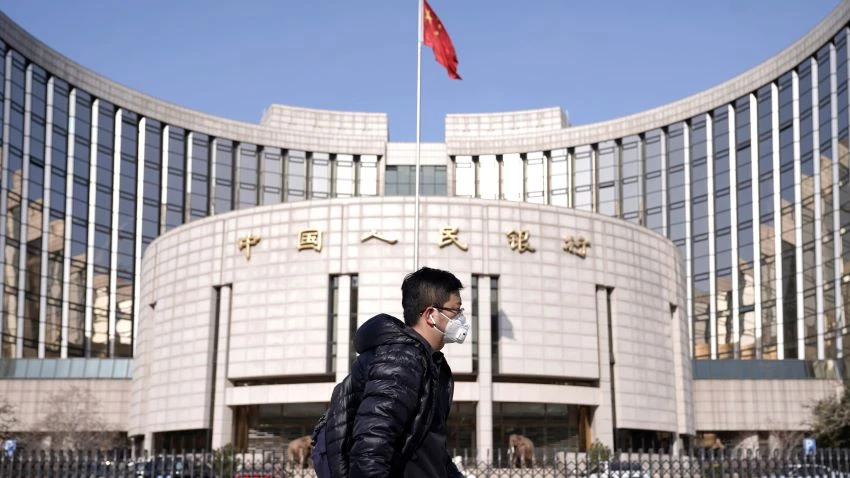
As the panicked stock sell-offs of recent days have shown, COVID-19 is having a huge impact on the global financial system.
Unlike during the 2008 global financial crisis, the problem is not overleveraged banks. Instead, economies are seizing up, cash flows are stopping and businesses are becoming unable to service their debts.
Central banks across much of the developing world have quickly brought their benchmark rates down to around zero if they were not already still lingering there from the last crisis. To fight the dramatic economic slowdown at hand from the new coronavirus, they now find themselves resorting to extreme measures which could have their own serious aftereffects.
This is not the case for the People's Bank of China, however. It may not be able to claim Western-style independence from government, but it finds itself now with significantly more policy room to maneuver because it has taken a radically different approach to financial regulation.
For a while now, the U.S. Federal Reserve, the European Central Bank and the Bank of England have been reviewing their strategies for fulfilling policy goals. A common theme has been puzzlement about the ineffectiveness of their monetary policy tool kits, a desire to avert blame for the next financial crisis and a consensus that fiscal policy is about all that is left to deploy in their economies.
The problem in developed economies, in short, is that since productive growth has been stagnant, they are not resilient, and since monetary policy has remained far out of normal bounds, there is not much room for policy adjustment.
COVID-19 has now sprung a liquidity trap just as Mark Carney, then governor of the Bank of England, warned in January could emerge with the next crisis: As stocks have sunk in the U.S., bond markets have failed to take up the slack.
The Fed quickly slashed policy rates and encouraged banks to use their capital and liquidity buffers to support households and businesses. The Bank of England also made cuts, lowered bank capital requirements and offered cheap funding to support small businesses.
 Chairman Jerome Powell speaks after the U.S. Federal Reserve cut interest rates in an emergency move on Mar. 3: the problem in developed economies is that there is not much room for policy adjustment. © Reuters
Chairman Jerome Powell speaks after the U.S. Federal Reserve cut interest rates in an emergency move on Mar. 3: the problem in developed economies is that there is not much room for policy adjustment. © Reuters The PBOC has more tools to adjust policy and maintain liquidity. In recent days, it has rolled out more than 30 measures to support lending to large banks and enterprises affected by the epidemic.
To free up even more capacity for lending, it has trimmed the share of funds banks are required to keep on reserve as a proportion of deposits and has hinted that it could allow banks to reduce the interest rates paid on deposits too.
The underlying policy differences between China and its Western peers go back to the Asian financial crisis. At the end of 1997, borrowers had fallen behind on payments on between a fifth and a quarter of all bank loans in China, an amount nearly equal to 20% of gross domestic product.
Beijing policymakers showed a critical grasp of two fundamental concepts: First, that banks create credit, the money an economy needs for productive growth.
Second, because commercial banks create up to 97% of new money, the economy is properly located on their balance sheets, rather than that of the central bank.
Beijing's priority in 1998 was to stabilize its banks and clean up their balance sheets. It injected fresh capital and transferred their nonperforming loans to so-called bad banks, which it labeled as asset management companies, to deal with. The loans were purchased from the banks at face value through a clever variant of quantitative easing.
By focusing on maintaining the balance-sheet capacity of its commercial banks to make productive loans, China put its economy back on a significant growth trajectory, avoiding a lost decade of credit contraction. Rather than banks' role in the wider economy, Western policymakers focused after 2008 on the safety of their commercial banks by requiring them to maintain a higher level of capital in proportion to their assets.
If commercial banks were simply intermediaries, then the impact of higher capital ratios would simply be higher interest rates on loans. But as creators of credit, heightened capital ratios reduce the capacity of bank balance sheets to create the new money needed for growth.
Bank capital is a bulwark against unexpected losses, the kind of losses set to be induced by COVID-19. Capital ratio requirements should rise to reflect higher asset risks and reduce leverage, not because times are good. It is a big ask by the Fed and its peers to expect banks to thin their capital protection now that times are bad.
In the West, central banks have used quantitative easing to buy up good assets instead of bad ones and have transferred a significant proportion of the economy onto their balance sheets, restricting room for further monetary policy adjustment. Bank regulation has raised capital ratios, crushing the capacity of commercial bank balance sheets and squeezing market liquidity.
Both the capacity and elasticity of bank balance sheets in the developed world have been compromised. This is why the West starts the fight against the global coronavirus recession from a worse place than China.




















